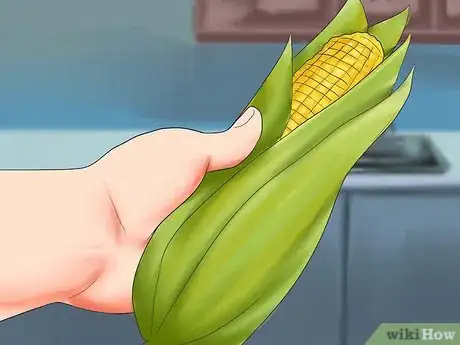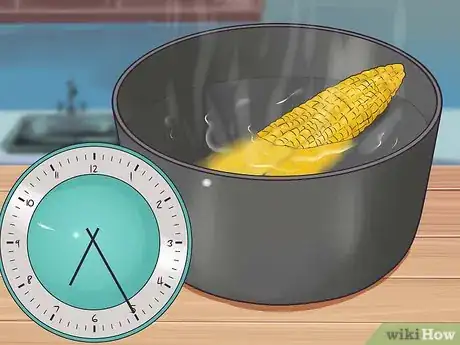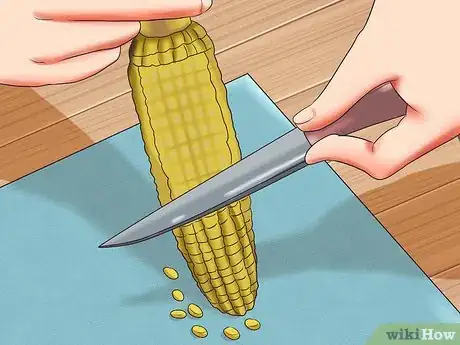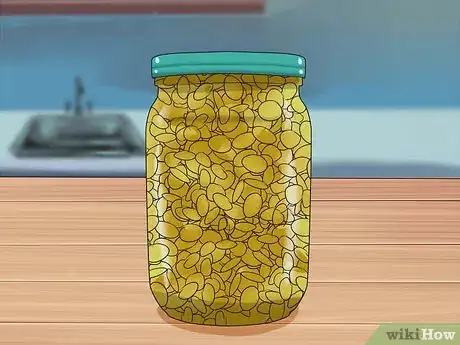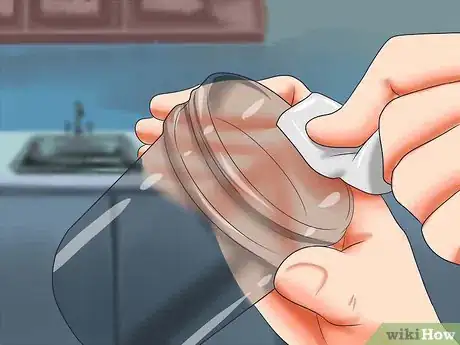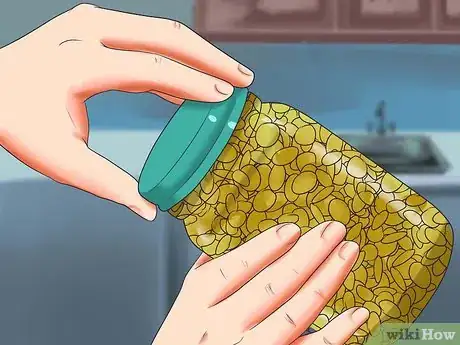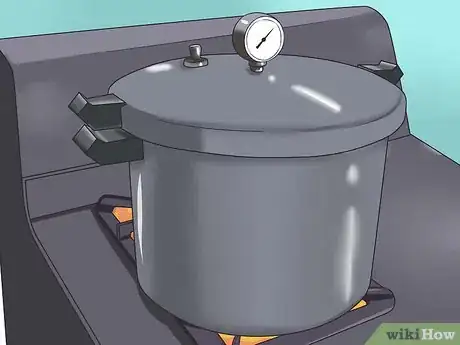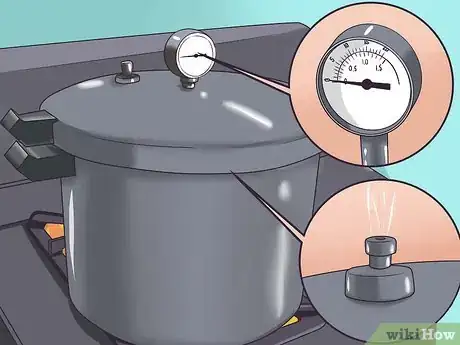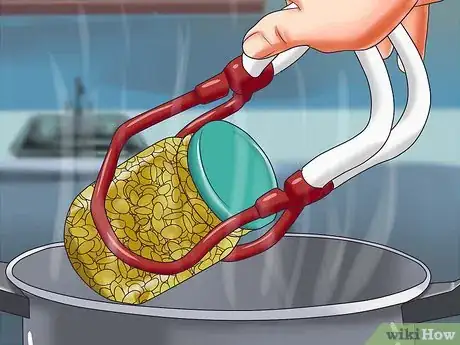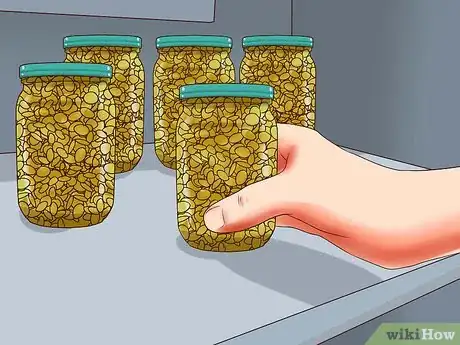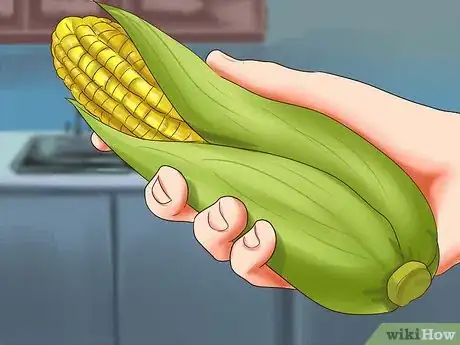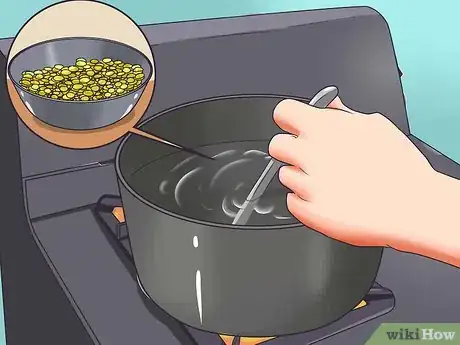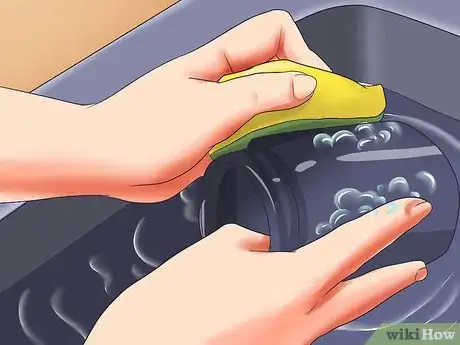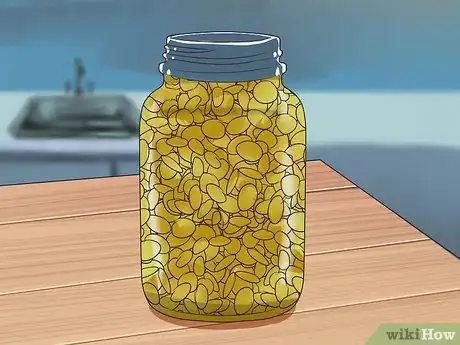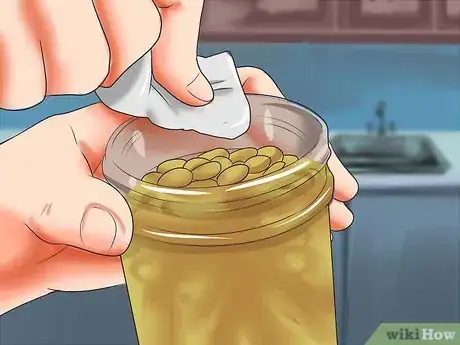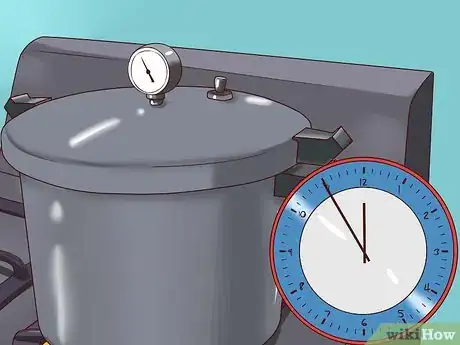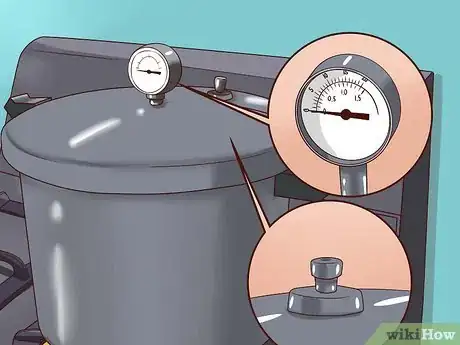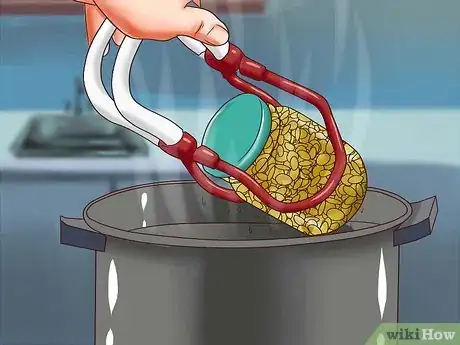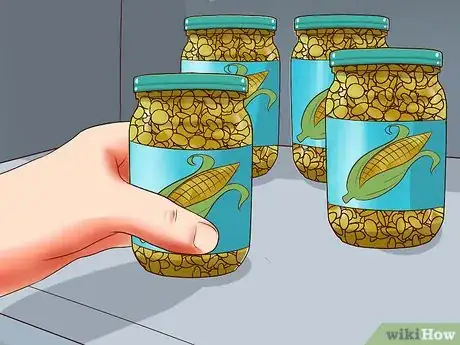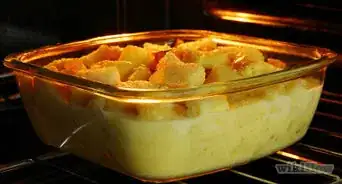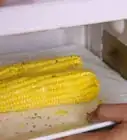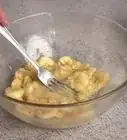wikiHow is a “wiki,” similar to Wikipedia, which means that many of our articles are co-written by multiple authors. To create this article, volunteer authors worked to edit and improve it over time.
This article has been viewed 19,505 times.
Learn more...
Preserve the fresh taste, bright yellow color and nutritional benefits of fresh corn by canning it at home. Since corn is a low-acid food, a pressure canner is required to prevent bacterial contamination.[1] Follow these straightforward directions to can corn using either the raw pack method, where the corn is quickly blanched to preserve color, or the hot pack method, which involves a slightly longer cooking time.
Ingredients
- 20 lb. (9 kg) sweet corn on the cob
- Canning salt (optional) [2]
Steps
Canning Corn with a Pressure Canner Using the Raw Pack Method
-
1Prepare the corn for canning. Select ripe, fresh corn with bright green husks and plump kernels.[3] Peel and remove husk and silk from the ears of corn. Wash and scrub the ears of corn with a vegetable brush under cool running water.
-
2Blanch the corn in boiling water for 2 minutes and remove them with tongs. [4] Transfer the corn to a large bowl of ice-cold water to stop the cooking process.
- Avoid cooking the corn for too long to avoid mushy kernels.
Advertisement -
3Slice the corn from the cob using a sharp knife starting from one end of the cob and slicing down. Catch the kernels in a large bowl or on a baking sheet.
- Avoid slicing into the cob, cutting only about 3/4 of the way through the kernels.
- Set the bottom end of the cob on a small, overturned bowl to make slicing and collecting the kernels easier.
-
4Clean 9 glass pint (500mL) canning jars and metal lids with soap and hot water. Keep the jars and lids hot until they are ready to be filled.
- Jars and lids can be kept hot by placing them upside down in a pot of hot water or by washing them in a dishwasher and keeping them in the dishwasher until needed.
-
5Pack the clean jars with the prepared corn leaving 1 inch (2.5 cm) of space at the top of the jars. Add one tsp. (5 mL) of canning salt to each jar (optional), then fill jars with boiling water, while keeping 1 inch (2.5 cm) of air space at the top of the jars. [5]
-
6Wipe the rims of the jars with a clean cloth, shake gently to allow air bubbles to escape and cover with the metal lids. Place the sealed jars on the rack in the pressure canner filled with 3 quarts (2.8 L) of hot water. [6]
- The jars must not sit directly on the bottom of the canner, and should not touch each other to allow steam to flow freely around them.
-
7Place the cover securely on the canner and heat water to boiling. Allow steam to vent from the canner for 10 minutes before adding canner weights or closing vents. After 10 minutes close vents or put on weights (depending on the type of pressure canner you are using) and allow the pressure to build.
-
8Process jars in the pressure canner for 55 minutes, adjusting the pressure based on your altitude (see guide below).[7] Start timing when the necessary pressure is reached. Check the gauge frequently to ensure the pressure remains constant.
- For dial gauge canners, set pressure to 11 PSI (75.8 kPa) for altitudes of 0 to 2000 feet (0 to 610 m), 12 PSI (82.7 kPa) for altitudes of 2001 to 4000 feet (610 to 1220 m), 13 PSI (89.6 kPa) for altitudes of 4,001 to 6,000 feet (1,000 to 2,000 m) (1220 to 1830 m), and 14 PSI (96.5 kPa) for 6001 to 8000 feet (1830 to 2440 m).
- For weighted gauge canners set pressure to 10 PSI (68.95 kPa) for altitudes of 0 to 1000 feet (0 to 305 m), and 15 PSI (103.4 kPa) for altitudes above 1,000 feet (304.8 m).
-
9Turn off heat and allow pressure to return to 0 PSI (0 kPa), then remove the weights or open the vent and wait for 2 minutes. Carefully remove lid and allow steam to escape.
-
10Remove the jars from the canner with a jar lifter and place them on a wooden board or thick kitchen towel to allow them to cool in a draft free area. Keep 1 to 2 inches (2.5 to 5 cm) of space between jars to allow air to circulate.
- Listen for a small “ping” sound indicating that the seal of the jar lids has been sucked down and the jars are properly sealed. This could take around 12 hours.
-
11Label the jars with ingredients and the date, then store in a cool, dark and dry location.
Canning Corn with a Pressure Canner Using the Hot Pack Method
-
1Prepare the corn for canning. Select ripe, fresh corn with bright green husks and plump kernels.[8] Peel and remove husk and silk from the ears of corn. Wash and scrub the ears of corn with a vegetable brush under cool running water.
-
2Slice the corn from the cob using a sharp knife starting from one end of the cob and slicing down. Catch the kernels in a large bowl or on a baking sheet.
- Avoid slicing into the cob, cutting only about 3/4 of the way through the kernels.
- Set the bottom end of the cob on a small, overturned bowl to make slicing and collecting the kernels easier.
-
3Add the corn to 5 cups (1.2 L) boiling water for 5 minutes, stirring frequently. [9]
- Avoid cooking the corn for too long to avoid mushy kernels.
-
4Clean 9 glass pint (500mL) canning jars and metal lids with soap and hot water. Keep the jars and lids hot until they are ready to be filled.
- Jars and lids can be kept hot by placing them upside down in a pot of hot water or by washing them in a dishwasher and keeping them in the dishwasher until needed.
-
5Pour the corn with cooking liquid into the clean jars leaving 1 inch (2.5 cm) of space at the top of the jars. Add one tsp. (5 mL) of canning salt to each jar (optional). [10]
-
6Wipe the rims of the jars with a clean cloth, stir gently with a clean, wooden spoon to allow air bubbles to escape and cover with the metal lids. Place the sealed jars on the rack in the pressure canner filled with 3 quarts (2.8 L) of hot water. [11]
- The jars must not sit directly on the bottom of the canner, and should not touch each other to allow steam to flow freely around them.
-
7Place the cover securely on the canner and heat water to boiling. Allow steam to vent from the canner for 10 minutes before adding canner weights or closing vents. After 10 minutes close vents or put on weights (depending on the type of pressure canner you are using) and allow the pressure to build.
-
8Process jars in the pressure canner for 55 minutes, adjusting the pressure based on your altitude (see guide below).[12] Start timing when the necessary pressure is reached. Check the gauge frequently to ensure the pressure remains constant.
- For dial gauge canners, set pressure to 11 PSI (75.8 kPa) for altitudes of 0 to 2000 feet (0 to 610 m), 12 PSI (82.7 kPa) for altitudes of 2001 to 4000 feet (610 to 1220 m), 13 PSI (89.6 kPa) for altitudes of 4,001 to 6,000 feet (1,000 to 2,000 m) (1220 to 1830 m), and 14 PSI (96.5 kPa) for 6001 to 8000 feet (1830 to 2440 m).
- For weighted gauge canners set pressure to 10 PSI (68.95 kPa) for altitudes of 0 to 1000 feet (0 to 305 m), and 15 PSI (103.4 kPa) for altitudes above 1,000 feet (304.8 m).
-
9Turn off heat and allow pressure to return to 0 PSI (0 kPa), then remove the weights or open the vent and wait for 2 minutes. Carefully remove lid and allow steam to escape.
-
10Remove the jars from the canner with a jar lifter and place them on a wooden board or thick kitchen towel to allow them to cool in a draft free area. Keep 1 to 2 inches (2.5 to 5 cm) of space between jars to allow air to circulate.
- Listen for a small “ping” sound indicating that the seal of the jar lids has been sucked down and the jars are properly sealed. This could take around 12 hours.
-
11Label the jars with ingredients and the date, then store in a cool, dark and dry location.
Community Q&A
-
QuestionHow many ears of corn does it take to fill 9 pint jars?
 Community AnswerWhile the yield of the corn kernels will obviously vary by the size of the cob, a good rule of thumb is to assume you will get about ¾ cup per ear.
Community AnswerWhile the yield of the corn kernels will obviously vary by the size of the cob, a good rule of thumb is to assume you will get about ¾ cup per ear.
Warnings
- If the lids on canning jars fail to seal (the button in the center does not pop down), use corn immediately and do not store them.⧼thumbs_response⧽
- If the corn smells sour or off in any way when you open the jars, discard immediately.⧼thumbs_response⧽
- To avoid the risk of botulism from bacterial contamination[13] , which can be life-threatening, follow instructions closely.⧼thumbs_response⧽
Things You’ll Need
- Pressure canner
- 9 Pint (500 mL) glass mason jars
- Canning lids with rings
- Jar lifter
- Kitchen towels
- Cutting board
- Sharp knife
- Kitchen scissors
- Large pot
- Large bowls
- Small bowl
References
- ↑ http://www.simplycanning.com/canning-corn.html
- ↑ https://www.thekitchn.com/what-is-pickling-salt-do-you-really-need-it-193108
- ↑ http://food52.com/blog/7700-how-to-choose-an-ear-of-corn-without-peeking
- ↑ http://www.simplycanning.com/canning-corn.html
- ↑ http://nchfp.uga.edu/how/can_04/corn_kernel.html
- ↑ http://www.simplycanning.com/pressure-canning.html
- ↑ http://nchfp.uga.edu/how/can_04/corn_kernel.html
- ↑ http://food52.com/blog/7700-how-to-choose-an-ear-of-corn-without-peeking
- ↑ http://www.simplycanning.com/canning-corn.html
About This Article
To can corn, pack glass pint jars with blanched corn, leaving 1 inch of space at the top. Once you seal the jars, place them in boiling water in the pressure cooker, and adjust the pressure based on your altitude. You should leave the jars in the pressure cooker for 55 minutes, checking the pressure gauge frequently to ensure the pressure remains constant. Finally, turn off the pressure cooker, and allow the pressure to return to 0 PSI before you open it and remove the jars. To learn how to can corn using the hot pack method, read on.
